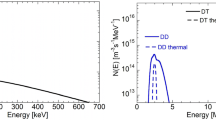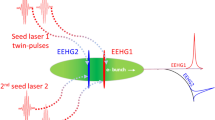Abstract
The motional Stark effect (MSE) diagnostic is used to measure the radial magnetic pitch-angle profile in neutral-beam-heated plasmas. The diagnostic relies upon the measurement of the polarization direction of Stark-split D-alpha emission from injected fast neutral atoms in a magnetic field. Measurements of the magnetic pitch angle are used with magnetic equilibrium reconstruction codes such as EFIT to calculate the safety factor in shaped plasmas. The MSE diagnostic is important for determining the shape of the q profile to optimize confinement and stability, and it has become a key element in high-performance tokamaks. For the purpose of achieving the high-performance operating region in the Korea Superconducting Tokamak Advanced Research KSTAR device, two types of methods are being studied. In KSTAR, a multichord PEM (photo-elastic modulator)-based MSE system is being developed, and an imaging MSE polarimetry system using the coherence imaging technique has been showing promising initial results during the last two KSTAR experimental campaigns in 2012 and 2013, respectively. In this paper, we describe the progress of the KSTAR MSE diagnostics.
Similar content being viewed by others
References
J. Howard, Plasma Phys. Control. Fusion 50, 125003 (2008).
J. Howard and **il Chung, Rev. Sci. Instrum. 83, 10D510 (2012).
A. Thorman, C. Michael, J. Howard, Rev. Sci. Instrum. 6, 063507 (2013).
B. W. Rice, D. G. Nilson and D. Wróblewski, Rev. Sci. Instrum. 66, 373 (1995).
S. H. Jeong et al., Rev. Sci. Instrum. 83, 02B102 (2012).
J. Howard, A. Diallo, R. Jaspers and J. Chung, J. Plasma Fusion Res. 5, S1010-1 (2010).
N. C. Hawkes, K. Blackler, B. Viaccoz, C. H. Wilson, J. B. Migozzi and B. C. Stratton, Rev. Sci. Instrum. 70, 894 (1999).
B. W. Rice, K. H. Burrell and L. L. Lao, Nuclear Fusion 37, 517 (1997).
T. Fujita, H. Kuko, T. Sugie, N. Isei and K. Ushigusa, Fusion Engin. Design 34–35, 289 (1997).
N. J. Conway et al., Rev. Sci. Instrum. 81, 10D738 (2010).
D. Moreau et al., Nucl. Fusion 43, 870 (2003).
Technical report, Ralph T. Huijgen, The Eindhoven University of Technology (2011).
Author information
Authors and Affiliations
Corresponding author
Rights and permissions
About this article
Cite this article
Chung, J., Ko, J., Howard, J. et al. Motional Stark effect diagnostics for KSTAR. Journal of the Korean Physical Society 65, 1257–1260 (2014). https://doi.org/10.3938/jkps.65.1257
Received:
Accepted:
Published:
Issue Date:
DOI: https://doi.org/10.3938/jkps.65.1257




